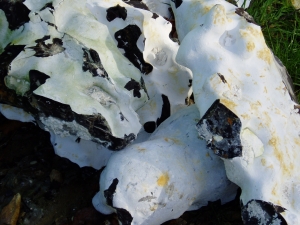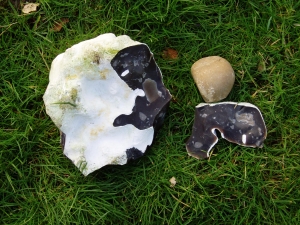Interpretation - Making stone tools

Flint nodules [Photo Francis Wenban-Smith]
Making stone tools
Some types of fine-grained rock have a crystalline structure that makes them fracture so as to form a sharp edge when struck with another piece of stone, or knapped.
Many volcanic rocks — or tuffs — have this property. Nodules of volcanic rock were common in the rift valley region of Africa, where hominids first learnt to make stone tools.
Volcanic rocks are, however, scarce in England. Luckily flint, which is common as nodules or layers within the Chalk of southern and central England, is particularly suitable for stone tool manufacture. Fresh nodules have a white cortex on the outside, but the interior flint is a dark glossy black.
Pieces of raw material need to be struck with another hard object (percussor) for flakes to be removed. A rounded piece of stone weighing 250g to 1kg is generally used as the percussor or hammerstone for knapping.

First flake off a flint nodule with a quartzite percussor [Photo Francis Wenban-Smith]
Percussors can also be made of softer organic material such as wood, bone or the proximal ends of shed antlers (soft hammers).
Hard hammers are used for removal of large flakes, and soft hammers are used for finer trimming and sharpening.
The plane of the knapping fracture is not flat, but undulates away from the point of percussion following a predictable path that depends upon the shape of the initial piece, the force of the blow and the angle of impact.
Thus the path of the fracture plane can be controlled by the knapper, leading, with skill and practice, to the removal of a series of flakes and the production of deliberately shaped lithic artefacts.
Throughout the Palaeolithic a great variety of types of stone tool were made. The handaxe is perhaps the definitive tool of the Palaeolithic, and requires remarkable skill to make.
It is worth reflecting that magnificent handaxes were being made in Africa by Homo erectus over 1 million years ago!